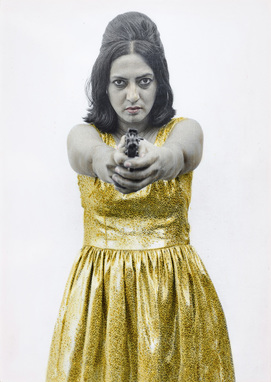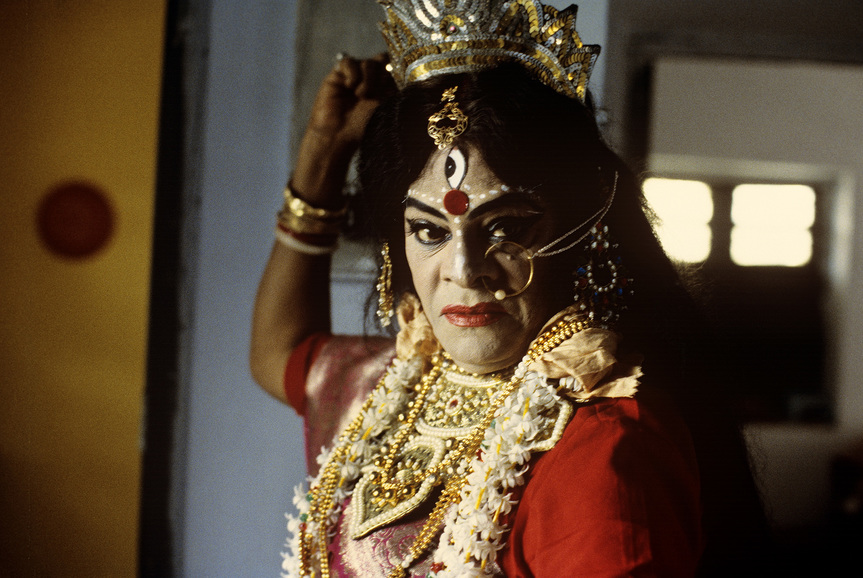-
From Current Issue
-
- Editor’s Letter Fire in the Heart
- Reviews I Gusti Ayu Kadek Murniasih
- Reviews 11th Seoul Mediacity Biennale: “One Escape at a Time”
- Dispatch Networked China
- One on One Monira Al Qadiri on Yukio Mishima
- Essays The rise of independent art spaces in pandemic-era Shanghai
- Features Tuan Andrew Nguyen
- Table of Contents
- Web Exclusives
- Archive
- Subscribe

R
E
V N
E
X
T
PUSHPAMALA N, Sunhere Sapne (Golden Dreams), 1998, hand-tinted black and white photograph, 22 × 17 cm. Courtesy the artist and Shumita and Arani Bose Collection, New York.
It wasn’t enough for Umrao Singh Sher-Gil, the son of an aristocrat, to have simply chosen a life of contemplation and study over one of business and politics; it seems he also wanted to be regarded as an intellectual in the eyes of others. In Sher-Gil’s self-portraits, displayed at the Vancouver Art Gallery, the autodidactic photographer appears performing yoga, behind a telescope, at his study, and, Rodin-esque with chin in hand, beside a pile of books on which his spectacles rest. Although they are intended to look spontaneous, they are conspicuously staged—attempts at self-branding that, in the context of the selfie phenomenon, are only dated in terms of their aesthetics.
It is this staged aspect of photography that the Vancouver Art Gallery focused its attention on in its latest exhibition, “Moving Still: Performative Photography in India.” Showcasing over a hundred works of photography (and also film) by 13 Indian artists from the 1800s to the present, the show examined the evolution of performative photography in the country, while also touching on particular subjects like sexuality and gender.
Shortly after its invention in France in the mid-19th century, the camera found an enthusiast in Sawai Ram Singh II, the Maharaja of Jaipur. A member of the Bengal Photographic Society, Singh delighted not only in taking pictures of himself to create and promote his own image, but also of the numerous wives in his harem and other sundry characters who peopled his court. As with Sher-Gil’s photographs, little, if anything, is impromptu in them, much attention having been given to poise, lighting, and composition. The sepia-tinted works of Nikhil Chopra in the exhibition, executed over a century later, echo the latter’s photographs in their regal aesthetics, and, more importantly, orchestrated posturing and assertion of character.
Vivan Sundaram, the grandson of Sher-Gil, heightens the performative in his photomontages of his grandfather’s images. In Preening (2001), Sundaram places a yoga-engrossed Sher-Gil beside a European woman in a sumptuously decorated boudoir, while some of his other works insert Sher-Gil’s daughters Amrita and Indira—absent from Sher-Gil’s photographs of himself—beside him, upending the original narrative by transforming them from seemingly passive figures in his life (as depicted in the original photographs) into active ones.
Taking the idea of narrative even further is Pushpamala N. Circus F-12, a piece in her “Ethnographic Series/Native Women of India: Manners and Customs” (2000–04) series, disrupts the British colonialist narrative of Indians as primitive subjects to be studied in its depiction of a woman in a polka-dot tutu. By contrast, the hand-colored “Sunhere Sapne (Golden Dreams)” series (1998), with its Bollywood-esque imagery, tells the story of a gun-toting fugitive (played by the artist) and her mini-adventures, in a style akin to that of her “Return of the Phantom Lady (Sinful City)” series (2012), in which Pushpamala plays two opposing characters in a bullet-riddled thriller.
Regarding gender and sexuality in the context of performativity, the works of Sonia Khurana, Naveen Kishore, and Sunil Gupta are of particular note. In her video Bird (1999), a naked Khurana attempts to fly, questioning and critiquing popular ideals of the female form in the process. There’s also Kishore’s video Performing the Goddess (1990), which shows the last male performer of the Bengali jatra dance tradition—who has faced homophobic discrimination—putting on makeup and dressing in drag before a show. Elsewhere, Gupta’s “Sun City” (2010) series—partly inspired by Chris Marker’s 1962 film La Jetée and also taking aesthetic and compositional cues from photographers Baron Von Gloeden and George Platt Lynes—depicts a young gay Indian man in a series of staged erotic encounters in Paris with predominantly white men.
Though it covers a broad spectrum of work in nearly every sense—temporal, visual, ideological, and sexual, to name a few—“Moving Still” nonetheless presented a coherent and compelling picture of performative Indian photography in bringing to the fore images from some of the country’s most notable artists—and enthusiasts—of the medium.
“Moving Still: Performative Photography in India” is on view at Vancouver Art Gallery until September 2, 2019.
To read more of ArtAsiaPacific’s articles, visit our Digital Library.


















